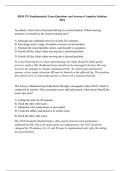Exam (elaborations)
HESI PN Fundamentals Exam Questions and Answers Complete Solution 2024
- Course
- HESI V2 (HESIPN)
- Institution
- Chamberlain College Of Nursing
An elderly client with a fractured left hip is on strict bedrest. Which nursing measure is essential to the client's nursing care? A. Massage any reddened areas for at least five minutes. B. Encourage active range of motion exercises on extremities. C. Position the client laterally, prone, and ...
[Show more]












